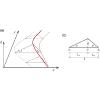当前位置:
X-MOL 学术
›
Phys. Rev. E
›
论文详情
Our official English website, www.x-mol.net, welcomes your
feedback! (Note: you will need to create a separate account there.)
Stabilization of a straight longitudinal dune under bimodal wind with large directional variation.
Physical Review E ( IF 2.2 ) Pub Date : 2020-01-01 , DOI: 10.1103/physreve.101.012903 Sachi Nakao-Kusune 1 , Takahiro Sakaue 2 , Hiraku Nishimori 3 , Hiizu Nakanishi 1
Physical Review E ( IF 2.2 ) Pub Date : 2020-01-01 , DOI: 10.1103/physreve.101.012903 Sachi Nakao-Kusune 1 , Takahiro Sakaue 2 , Hiraku Nishimori 3 , Hiizu Nakanishi 1
Affiliation

|
It has been observed that the direction in which a sand dune extends its crest line depends on seasonal variation of wind direction; when the variation is small, the crest line develops more or less perpendicularly to the mean wind direction to form a transverse dune with some undulation. In the case of bimodal wind with a large relative angle, however, the dune extends its crest along the mean wind direction and evolves into an almost straight longitudinal dune. Motivated by these observations, we investigate the dynamical stability of isolated dunes using the crest line model, where the dune dynamics is represented by its crest line motion. First, we extend the previous linear stability analysis under the unidirectional wind to the case with nonzero slant angle between the wind direction and the normal direction of the crest line, and show that the stability diagram does not depend on the slant angle. Second, we examine how the linear stability is affected by the seasonal changes of wind direction in the case of bimodal wind with equal strength and duration. For the transverse dune, we find that the stability is virtually the same with that for the unidirectional wind as long as the dune evolution during a season is small. On the other hand, in the case of the longitudinal dune, the dispersions of the growth rates for the perturbation are drastically different from those of the unidirectional wind, and we find that the largest growth rate is always located at k=0. This is because the growth of the perturbation with k≠0 is canceled by the alternating wind from opposite sides of the crest line even though it grows during each duration period of the bimodal wind. For a realistic parameter set, the system is in the wavy unstable regime of the stability diagram for the unidirectional wind, thus the straight transverse dune is unstable to develop undulation and eventually evolves into a string of barchans when the seasonal variation of wind direction is small, but the straight longitudinal dune is stabilized under the large variation of bimodal wind direction. We also perform numerical simulations on the crest line model, and find that the results are consistent with our linear analysis and the previous reports that show that the longitudinal dunes tend to have a straight ridge elongating over time.
中文翻译:

双峰风作用下直向纵向沙丘的稳定,方向变化较大。
已经观察到,沙丘延伸其波峰线的方向取决于风向的季节性变化。当变化较小时,波峰线或多或少地垂直于平均风向发展,形成具有一定起伏的横向沙丘。但是,在双峰风的相对角度较大的情况下,沙丘沿平均风向延伸其波峰,并演变成几乎笔直的纵向沙丘。根据这些观察结果,我们使用波峰线模型研究孤立沙丘的动力学稳定性,其中沙丘动力学由其波峰线运动表示。首先,我们将先前在单向风下的线性稳定性分析扩展到风向与波峰线法线方向之间的倾斜角为非零的情况,并表明稳定性图与倾斜角无关。其次,在强度和持续时间相同的双峰风情况下,我们研究了线性稳定性如何受到风向的季节性变化的影响。对于横向沙丘,我们发现只要季节内沙丘的演变很小,其稳定性与单向风的稳定性几乎相同。另一方面,在纵向沙丘的情况下,扰动的增长率的离散与单向风的离散大不相同,我们发现最大的增长率始终位于k = 0处。这是因为,即使波峰在双峰风的每个持续时间内都在增长,k≠0的扰动的增长也会被波峰线相对两侧的交变风抵消。对于一个现实的参数集,系统处于单向风稳定图的波浪不稳定状态,因此直的横向沙丘不稳定并发展起伏,最终在风向的季节性变化较小时演变成一串巴坎。 ,但是在双峰风向变化较大的情况下,笔直的纵向沙丘是稳定的。我们还对波峰线模型进行了数值模拟,发现结果与我们的线性分析和先前的报告一致,这些报告表明,纵向沙丘随着时间的流逝倾向于具有笔直的山脊。因此,当风向的季节变化较小时,笔直的横向沙丘不稳定并发展为起伏状,最终演变成一串巴坎,但在双峰风向的大变化下,笔直的纵向沙丘得以稳定。我们还对波峰线模型进行了数值模拟,发现结果与我们的线性分析和先前的报告一致,这些报告表明,纵向沙丘随着时间的流逝倾向于具有笔直的山脊。因此,当风向的季节变化较小时,笔直的横向沙丘不稳定并发展为起伏状,最终演变成一串巴坎,但在双峰风向的大变化下,笔直的纵向沙丘得以稳定。我们还对波峰线模型进行了数值模拟,发现结果与我们的线性分析和先前的报告一致,这些报告表明,纵向沙丘随着时间的流逝倾向于具有笔直的山脊。
更新日期:2020-01-14
中文翻译:

双峰风作用下直向纵向沙丘的稳定,方向变化较大。
已经观察到,沙丘延伸其波峰线的方向取决于风向的季节性变化。当变化较小时,波峰线或多或少地垂直于平均风向发展,形成具有一定起伏的横向沙丘。但是,在双峰风的相对角度较大的情况下,沙丘沿平均风向延伸其波峰,并演变成几乎笔直的纵向沙丘。根据这些观察结果,我们使用波峰线模型研究孤立沙丘的动力学稳定性,其中沙丘动力学由其波峰线运动表示。首先,我们将先前在单向风下的线性稳定性分析扩展到风向与波峰线法线方向之间的倾斜角为非零的情况,并表明稳定性图与倾斜角无关。其次,在强度和持续时间相同的双峰风情况下,我们研究了线性稳定性如何受到风向的季节性变化的影响。对于横向沙丘,我们发现只要季节内沙丘的演变很小,其稳定性与单向风的稳定性几乎相同。另一方面,在纵向沙丘的情况下,扰动的增长率的离散与单向风的离散大不相同,我们发现最大的增长率始终位于k = 0处。这是因为,即使波峰在双峰风的每个持续时间内都在增长,k≠0的扰动的增长也会被波峰线相对两侧的交变风抵消。对于一个现实的参数集,系统处于单向风稳定图的波浪不稳定状态,因此直的横向沙丘不稳定并发展起伏,最终在风向的季节性变化较小时演变成一串巴坎。 ,但是在双峰风向变化较大的情况下,笔直的纵向沙丘是稳定的。我们还对波峰线模型进行了数值模拟,发现结果与我们的线性分析和先前的报告一致,这些报告表明,纵向沙丘随着时间的流逝倾向于具有笔直的山脊。因此,当风向的季节变化较小时,笔直的横向沙丘不稳定并发展为起伏状,最终演变成一串巴坎,但在双峰风向的大变化下,笔直的纵向沙丘得以稳定。我们还对波峰线模型进行了数值模拟,发现结果与我们的线性分析和先前的报告一致,这些报告表明,纵向沙丘随着时间的流逝倾向于具有笔直的山脊。因此,当风向的季节变化较小时,笔直的横向沙丘不稳定并发展为起伏状,最终演变成一串巴坎,但在双峰风向的大变化下,笔直的纵向沙丘得以稳定。我们还对波峰线模型进行了数值模拟,发现结果与我们的线性分析和先前的报告一致,这些报告表明,纵向沙丘随着时间的流逝倾向于具有笔直的山脊。











































 京公网安备 11010802027423号
京公网安备 11010802027423号